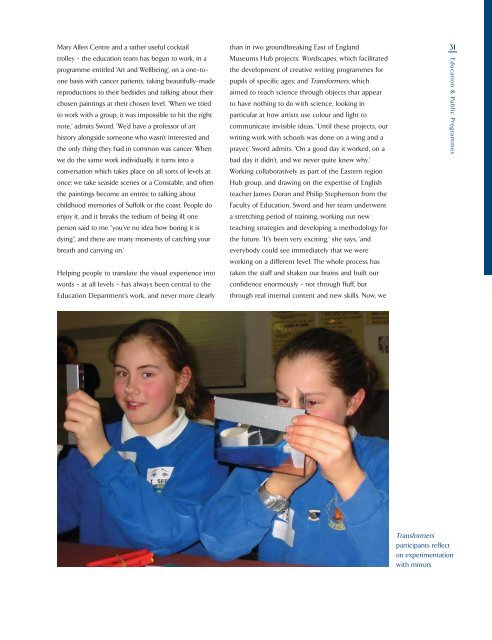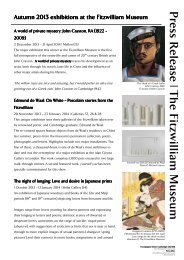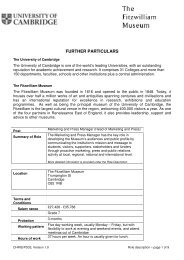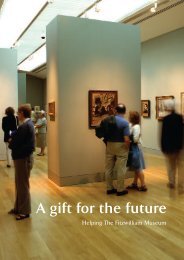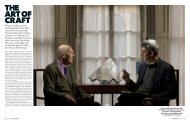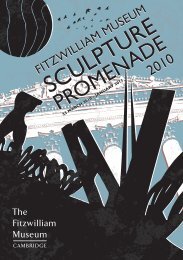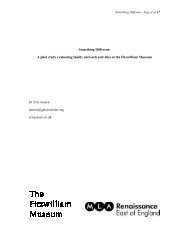The Fitzwilliam Museum - University of Cambridge
The Fitzwilliam Museum - University of Cambridge
The Fitzwilliam Museum - University of Cambridge
Create successful ePaper yourself
Turn your PDF publications into a flip-book with our unique Google optimized e-Paper software.
Mary Allen Centre and a rather useful cocktail<br />
trolley - the education team has begun to work, in a<br />
programme entitled ‘Art and Wellbeing’, on a one-toone<br />
basis with cancer patients, taking beautifully-made<br />
reproductions to their bedsides and talking about their<br />
chosen paintings at their chosen level. ‘When we tried<br />
to work with a group, it was impossible to hit the right<br />
note,’ admits Sword. ‘We’d have a pr<strong>of</strong>essor <strong>of</strong> art<br />
history alongside someone who wasn’t interested and<br />
the only thing they had in common was cancer. When<br />
we do the same work individually, it turns into a<br />
conversation which takes place on all sorts <strong>of</strong> levels at<br />
once; we take seaside scenes or a Constable, and <strong>of</strong>ten<br />
the paintings become an entrée to talking about<br />
childhood memories <strong>of</strong> Suffolk or the coast. People do<br />
enjoy it, and it breaks the tedium <strong>of</strong> being ill; one<br />
person said to me “you’ve no idea how boring it is<br />
dying”, and there are many moments <strong>of</strong> catching your<br />
breath and carrying on.’<br />
Helping people to translate the visual experience into<br />
words - at all levels - has always been central to the<br />
Education Department’s work, and never more clearly<br />
than in two groundbreaking East <strong>of</strong> England<br />
<strong>Museum</strong>s Hub projects: Wordscapes, which facilitated<br />
the development <strong>of</strong> creative writing programmes for<br />
pupils <strong>of</strong> specific ages; and Transformers, which<br />
aimed to teach science through objects that appear<br />
to have nothing to do with science, looking in<br />
particular at how artists use colour and light to<br />
communicate invisible ideas. ‘Until these projects, our<br />
writing work with schools was done on a wing and a<br />
prayer,’ Sword admits. ‘On a good day it worked, on a<br />
bad day it didn’t, and we never quite knew why.’<br />
Working collaboratively as part <strong>of</strong> the Eastern region<br />
Hub group, and drawing on the expertise <strong>of</strong> English<br />
teacher James Doran and Philip Stephenson from the<br />
Faculty <strong>of</strong> Education, Sword and her team underwent<br />
a stretching period <strong>of</strong> training, working out new<br />
teaching strategies and developing a methodology for<br />
the future. ‘It’s been very exciting,‘ she says, ‘and<br />
everybody could see immediately that we were<br />
working on a different level. <strong>The</strong> whole process has<br />
taken the staff and shaken our brains and built our<br />
confidence enormously - not through fluff, but<br />
through real internal content and new skills. Now, we<br />
31<br />
Transformers<br />
participants reflect<br />
on experimentation<br />
with mirrors<br />
Education & Public Programmes


